Risk return tradeoff - Study guides, Class notes & Summaries
Looking for the best study guides, study notes and summaries about Risk return tradeoff? On this page you'll find 95 study documents about Risk return tradeoff.
Page 3 out of 95 results
Sort by
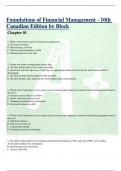
-
FoundationsofFinancialManagement-10th CanadianEditionbyBlock Chapter01 1.What is the primary goal of financial management? A.Increased earnings B.Maximizing cash flow C.Maximizing shareholder wealth D.Minimizing risk of the firm 2.Proper risk-return manag
- Exam (elaborations) • 1335 pages • 2023
-
- $10.49
- + learn more
FoundationsofFinancialManagement-10th CanadianEditionbyBlock Chapter01 1.What is the primary goal of financial management? A.Increased earnings B.Maximizing cash flow C.Maximizing shareholder wealth D.Minimizing risk of the firm 2.Proper risk-return management means that: A.the firm should take as few risks as possible. B.consistent with the objectives of the firm, an appropriate trade-off between risk and return should be determined. C.the firm should earn the highest return possibl...

-
Exam 2 RMI 2302 - FSU Dr. Nyce Exam Questions With Verified Answers
- Exam (elaborations) • 10 pages • 2024
- Available in package deal
-
- $12.49
- + learn more
Exam 2 RMI 2302 - FSU Dr. Nyce Exam Questions With Verified Answers Who uses decision making ? - answerIndividuals Organizations Government Individuals use expected ____ - answerUtility Organizations use expected ____ - answerValue What entity is able to take on risk regardless of the reward - answerGov't What is one of the big problems we have with modeling how decisions are made? - answerDecisions are made is that they do not explicitly account for biases on the part of the decision...

-
FNAN 307 Test 1 ULL | Questions with 100% Correct Answers | Updated & Verified
- Exam (elaborations) • 6 pages • 2023
-
- $8.49
- + learn more
Who uses financial statements and in what capacity or manner? - Management- Minimize cost of capitol, maximize shareholder's wealth What is the purpose of financial reporting? - For management to minimize the cost of capitol and maximize wealth of the firm Why should a firm use some debt with interest costs in its capital structure? - Lower cost in equity b/c tax deductions, Risk-return tradeoff Magnifies earnings Describe the adversarial nature of financial reporting. - Accountants- Giv...
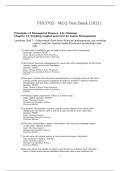
-
FIN3702 - MCQ Test Bank (2021)
- Exam (elaborations) • 78 pages • 2024
-
- $17.79
- + learn more
FIN3702 - MCQ Test Bank (2021) Principles of Managerial Finance, 12e (Gitman) Chapter 14 Working Capital and Current Assets Management Learning Goal 1: Understand short-term financial management, net working capital, and the related tradeoff between profitability and risk. 1) A firm that is unable to pay its bills as they come due is technically insolvent. Answer: TRUE Topic: Basics of Short-Term Financial Management Question Status: Previous Edition 2) Short-term financial managemen...
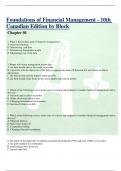
-
FoundationsofFinancialManagement-10th CanadianEditionbyBlock Chapter01 1.What is the primary goal of financial management? A.Increased earnings B.Maximizing cash flow C.Maximizing shareholder wealth D.Minimizing risk of the firm 2.Proper risk-return manag
- Exam (elaborations) • 1335 pages • 2023
-
- $10.49
- + learn more
FoundationsofFinancialManagement-10th CanadianEditionbyBlock Chapter01 1.What is the primary goal of financial management? A.Increased earnings B.Maximizing cash flow C.Maximizing shareholder wealth D.Minimizing risk of the firm 2.Proper risk-return management means that: A.the firm should take as few risks as possible. B.consistent with the objectives of the firm, an appropriate trade-off between risk and return should be determined. C.the firm should earn the highest return possibl...
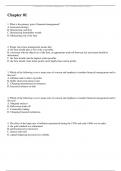
-
Foundations of Financial Management - 10th Canadian Edition by Block Chapter 01 1.What is the primary goal of financial management? A.Increased earnings B.Maximizing cash flow C.Maximizing shareholder wealth D.Minimizing risk of the firm 2.Proper risk-re
- Exam (elaborations) • 1334 pages • 2023
-
- $10.49
- + learn more
Foundations of Financial Management - 10th Canadian Edition by Block Chapter 01 1.What is the primary goal of financial management? A.Increased earnings B.Maximizing cash flow C.Maximizing shareholder wealth D.Minimizing risk of the firm 2.Proper risk-return management means that: A.the firm should take as few risks as possible. B.consistent with the objectives of the firm, an appropriate tradeoff between risk and return should be determined. C.the firm should earn the highest return...
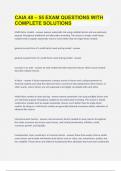
-
CAIA 48 – 55 EXAM QUESTIONS WITH COMPLETE SOLUTIONS
- Exam (elaborations) • 6 pages • 2023
- Available in package deal
-
- $14.99
- + learn more
Multi-factor models express systematic risk using multiple factors and are extremely popular throughout traditional and alternative investing. The reason is simple: multi-factor models tend to explain systematic returns much better than do single-factor models. general ex ante form of a multi-factor asset pricing model general ex poste form of a multi-factor asset pricing model ex poste vs ex ante ex ante models describe expected returns while ex post models describe rea...
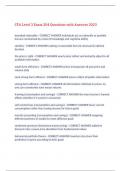
-
CFA Level 3 Exam 204 Questions with Answers 2023,100% CORRECT
- Exam (elaborations) • 22 pages • 2023
-
- $11.49
- + learn more
CFA Level 3 Exam 204 Questions with Answers 2023 bounded rationality - CORRECT ANSWER individuals act as rationally as possible but are constrained by a lack of knowledge and cognitive ability satisfice - CORRECT ANSWER making a reasonable but not necessarily optimal decision the price is right - CORRECT ANSWER asset prices reflect and instantly adjust to all available information weak-form efficiency - CORRECT ANSWER prices inncoporate all past price and volume data semi-strong...

-
FIN3702 - MCQ Test Bank (2021)
- Exam (elaborations) • 78 pages • 2024
-
- $11.99
- + learn more
FIN3702 - MCQ Test Bank (2021) Principles of Managerial Finance, 12e (Gitman) Chapter 14 Working Capital and Current Assets Management Learning Goal 1: Understand short-term financial management, net working capital, and the related tradeoff between profitability and risk. 1) A firm that is unable to pay its bills as they come due is technically insolvent. Answer: TRUE Topic: Basics of Short-Term Financial Management Question Status: Previous Edition 2) Short-term financial managemen...
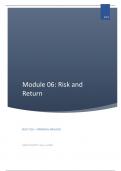
-
BUSI 7110 Class Notes - MODULE 06: RISK AND RETURN
- Class notes • 17 pages • 2023
- Available in package deal
-
- $8.39
- + learn more
All of the class notes and supporting documentation for Module 06: Risk and Return in BUSI 7110 - Financial Analysis. These notes cover weeks 8-9 of class. The notes are broken out by individual lectures and the major topics covered include (1) Risk-Return Tradeoff, (2) Measures of Risk, (3) Expected Returns, and (4) the Capital Asset Pricing Model. Important quotes from the professor are included in quotations and all formulas are highlighted in yellow for easy reference.

$6.50 for your textbook summary multiplied by 100 fellow students... Do the math: that's a lot of money! Don't be a thief of your own wallet and start uploading yours now. Discover all about earning on Stuvia


